These Are The Incredible Varieties Being Grown By Orchid Societies And Nurseries

HOUSEPLANTS > ORCHIDS > VARIETIES

Elizabeth is a Permaculture Garden Designer, Sustainability Consultant and Professional Writer, working as an advocate for positive change. She graduated from the University of St. Andrews with an MA in English and Philosophy and obtained a Diploma in Applied Permaculture Design from the Permaculture Association.
Reviewed By PETER LICKORISH

Peter is a Horticulture Lecturer and self-employed Horticulturist, with a passion for diverse areas of the industry - from garden design to the science behind plant growth and propagation. He has completed the Royal Horticultural Society’s Master of Horticulture (MHort) Award and lectures on RHS courses at Bedford College.
Contributions From DANIEL TOOR

Daniel is the owner of The Dark Orchid, a specialist orchid seller that ships exotic and rare orchid varieties throughout the UK. Some of the orchids for sale can be found on his Instagram page, where he shares photos of some stunning varieties.

As a lover of orchids that has been growing and caring for these plants for around 45 years, Ken is now the Chairman of Bournemouth Orchid Society, of which he has been a member since the 1980s. The society won a Silver-Gilt Medal at the RHS Wilsey Orchid show in 2022. Ken has also spoken at many events as a guest speaker, sharing his knowledge of orchids with hundreds of people.

Malcolm has been growing orchids for 30 years and had lots of experience searching for, growing and caring for orchids. He previously ran his own business providing orchid sundries to hobbyist growers and he also delivers lectures to various orchid and gardening clubs across the UK. Malcolm is currently the Chairman, Vice President and Show Secretary of the Solihull & District Orchid Society.

With several published books on the topic of orchids, Sara is the owner of Burnham Nurseries Ltd, one of the UK’s leading orchid sellers that first opened over 70 years ago. Sara has worked for the nursery for 32 years, during which time she has won various awards, most recently winning a Gold Medal at the RHS Wisley Orchid Show in 2022.
IN THIS GUIDE
- 1) Cymbidium ‘Dorothy Stockstill’
- 2) C. erythraeum
- 3) C. lowianum
- 4) C. ‘Nagalex’
- 5) C. ‘Tiger Tail’
- 6) Dendrobium ‘Berry’
- 7) D. kingianum
- 8) D. nobile
- 9) Miltonia ssp.
- 10) Oncidium naevium
- 11) Paphiopedilum ‘Clair de Lune’
- 12) P. insigne
- 13) P. ‘Leeanum’
- 14) P. ‘Pinocchio’
- 15) Phalaenopsis amabilis
- 16) P. ‘Dover’
- 17) P. ‘Picasso’
- 18) P. ‘Sunshine’
- 19) P. ‘White Apple’
- 20) P. ‘Yellow Lightning’
ORCHID GUIDES
Orchids are notorious for being fussy plants, but some are easier to grow as houseplants than you might think.
“When selecting an orchid, your uppermost considerations, other than aesthetics, should be its season of flowering, whether it’s terrestrial or epiphytic, its light preferences, and its temperature needs,” shares Peter Lickorish, a Master Horticulturist.
“Although most orchids need differing day and night temperatures, they can be broadly classified as warm-growing, intermediate-growing or cool-growing. For light levels, some prefer longer durations of less bright light, while others need brighter conditions.”
Moth orchids, Phalaenopsis, are the most commonly grown as houseplants in the UK.
However, as you can see from the list below, there are not only many of these orchids to choose from but also many other orchid varieties that you might grow.
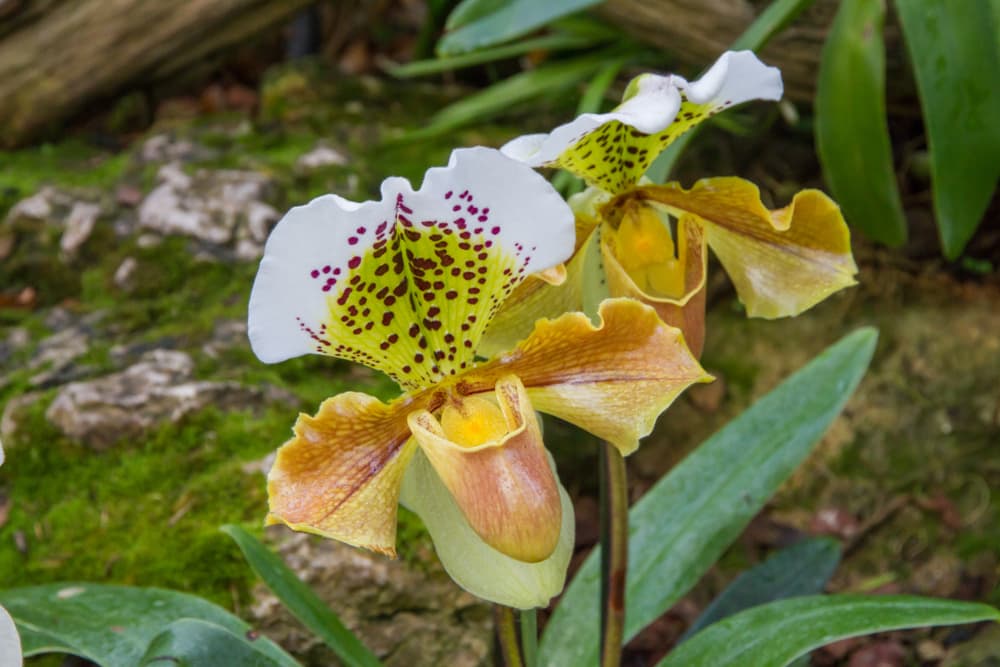
“It is indeed challenging to choose a favourite orchid type or variety, as they each possess their own unique characteristics and charm,” says Daniel Toor, Owner of the specialist nursery The Dark Orchid.
“I am constantly enthralled by the vast array of orchid shapes, sizes and colours, as well as the intricacies of their leaves, bulbs, roots, growth patterns and preferred environments.
“To me, each orchid is like a character with its own distinct appearance, requirements and personality.
“All in all, it is their diversity and beauty that ignites my passion for growing these fascinating plants.”
Let’s explore just some of the highly regarded species and hybrid cultivars to help you find the right orchid for you and your home.
1) Cymbidium ‘Dorothy Stockstill’
- COMMON NAME(S): boat orchid ‘Dorothy Stockstil’
- HARDINESS RATING: H1C
- FLOWERS: red
- FLOWERING SEASON(S): winter / spring
- SIZE: 0.5-1m in height, 0.5-1m spread
This is a highly floriferous boat orchid which bears reddish-brown flowers with a maroon lip from winter into the spring.
It should be grown in a neutral and well-drained loam, in a reasonably bright location out of direct sunlight, and needs minimum temperatures of 16°C during the day and 10°C at night.
This hybrid variety, with its pendulous flower spikes, looks good growing in a basket.
2) C. erythraeum
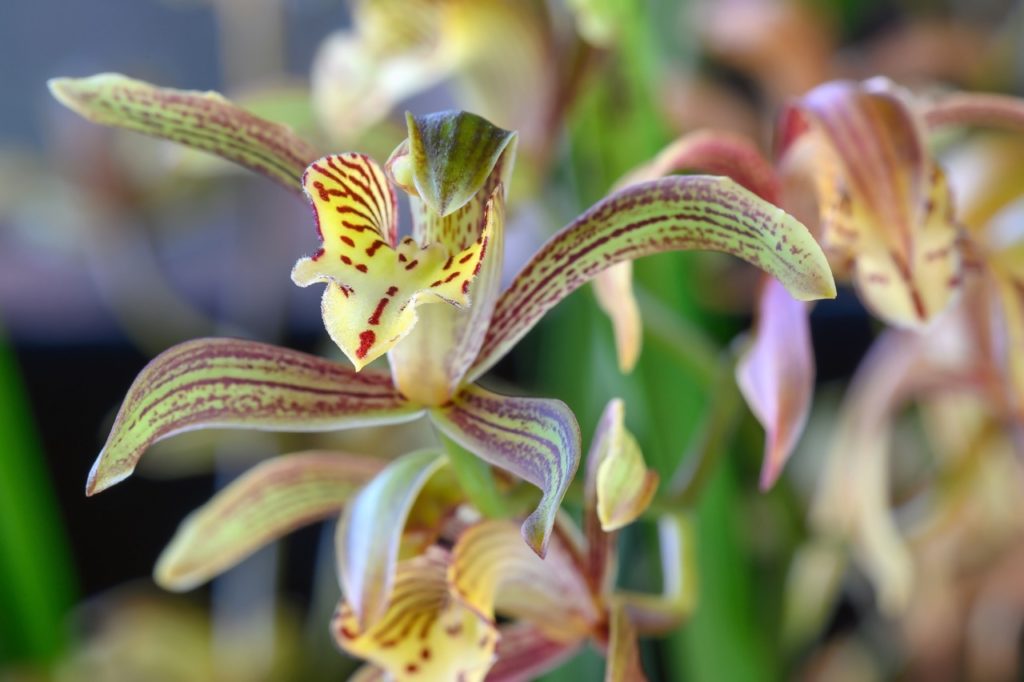
- COMMON NAME(S): Indian cymbidium
- HARDINESS RATING: H1C
- FLOWERS: red, green and white
- FLOWERING SEASON(S): autumn / winter
- SIZE: 0.5-1m in height, 0.1-0.5m spread
Requiring around the same temperatures and conditions as the above, this boat orchid has bright green leaves that sometimes have dark spots.
In autumn and during the winter, it has long arching stems that carry around a dozen blooms.
These are around 8cm across and have 5 narrow outer petals that are green with red spots and a tubular centre that is green with dark red markings and a white lip.
3) C. lowianum
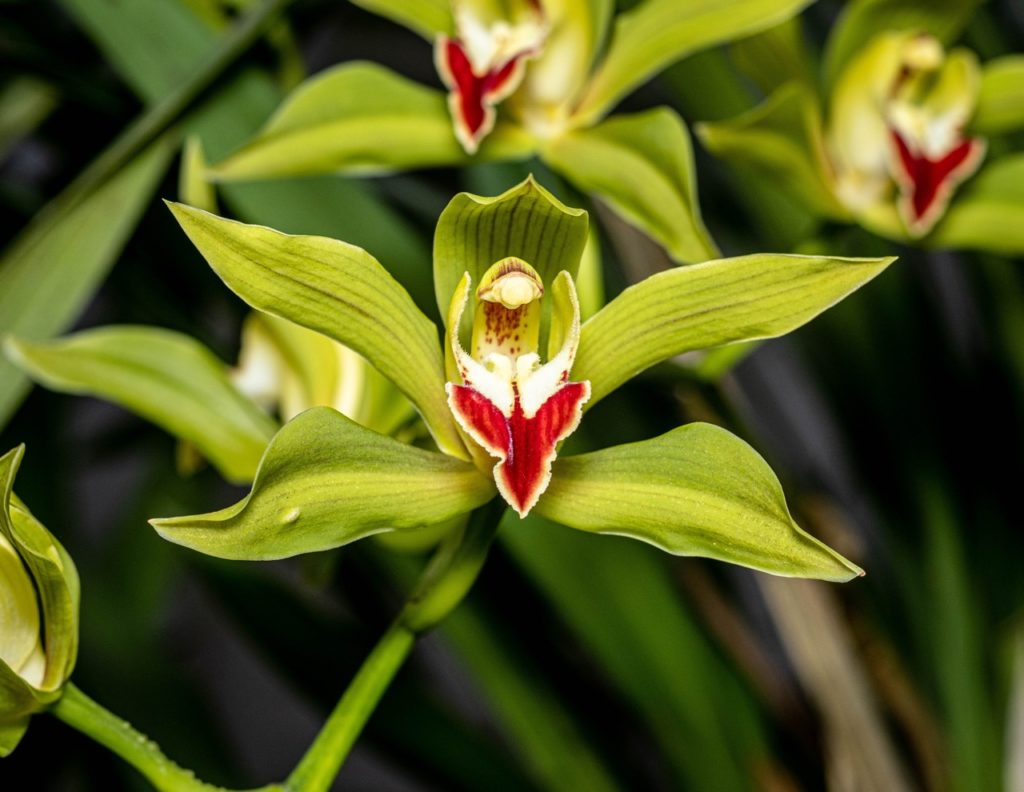
- COMMON NAME(S): low’s boat orchid
- HARDINESS RATING: H1C
- FLOWERS: green and red
- FLOWERING SEASON(S): autumn / winter
- SIZE: 0.5-1m in height, 0.5-1m spread
This boat orchid is a large epiphytic species that grows to around 90cm in height.
It will grow best in cooler conditions.
The flowers are a vivid shade of apple green, with deep red edges to the lip, and these bloom on long, arching stems from autumn through to the winter and sometimes into early spring.
Again, these are houseplants, with a hardiness rating of H1C.
4) C. ‘Nagalex’
- COMMON NAME(S): cymbidium ‘nagalex’
- HARDINESS RATING: H1C
- FLOWERS: green and white
- FLOWERING SEASON(S): summer
- SIZE: 0.5-1m in height, 0.5-1m spread
Another option which can bloom over a long period of time, this boat orchid is extremely floriferous and can bloom continuously for more than three months.
This is another potential houseplant that needs daytime temperatures of 16°C and 10°C during the night.
The flowers are a yellowy-green hue with a white lip and they have a sweet fragrance.
5) C. ‘Tiger Tail’
- COMMON NAME(S): tiger tail cymbidum
- HARDINESS RATING: H1C
- FLOWERS: yellow and purple
- FLOWERING SEASON(S): winter
- SIZE: 0.1-0.5m in height, 0.1-0.5m spread
A dwarf, free-flowering terrestrial orchid that grows to around 30cm in height and spread, this option has long linear leaves and produces yellow to olive green flowers with white tinted peachy lip on gently arching spokes.
These flowers bloom in the early winter.
6) Dendrobium ‘Berry’
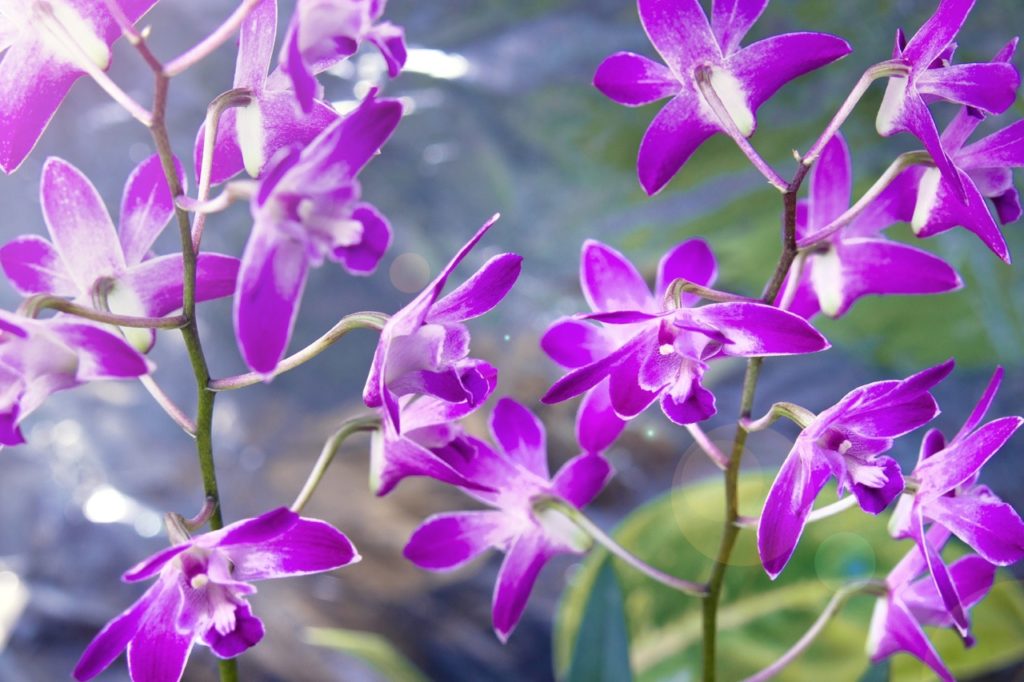
- COMMON NAME(S): rock orchid ‘berry’
- HARDINESS RATING: H1B
- FLOWERS: pink
- FLOWERING SEASON(S): spring / summer / autumn / winter
- SIZE: 0.1-0.5m in height, 0.1-0.5m spread
“At our nursery, we love to grow many of the species, especially dendrobiums,” shares the owner of Burnham Nurseries, Sara Rittershausen.
“We have some that flower in any season and enjoy the cooler temperatures, and many have a lovely scent which is a real bonus!”
This small, terrestrial orchid is a hybrid of D. kingianum (see below) and D. ‘Mini Pearl’.
It grows around 38cm tall and 30cm wide.
It has leathery green leaves and purplish pink flowers which are 2cm across, borne on sprays which grow upright from the pseudobulb tips in the spring.
Daytime temperatures of 18-25°C and nights above 12°C are required.
7) D. kingianum
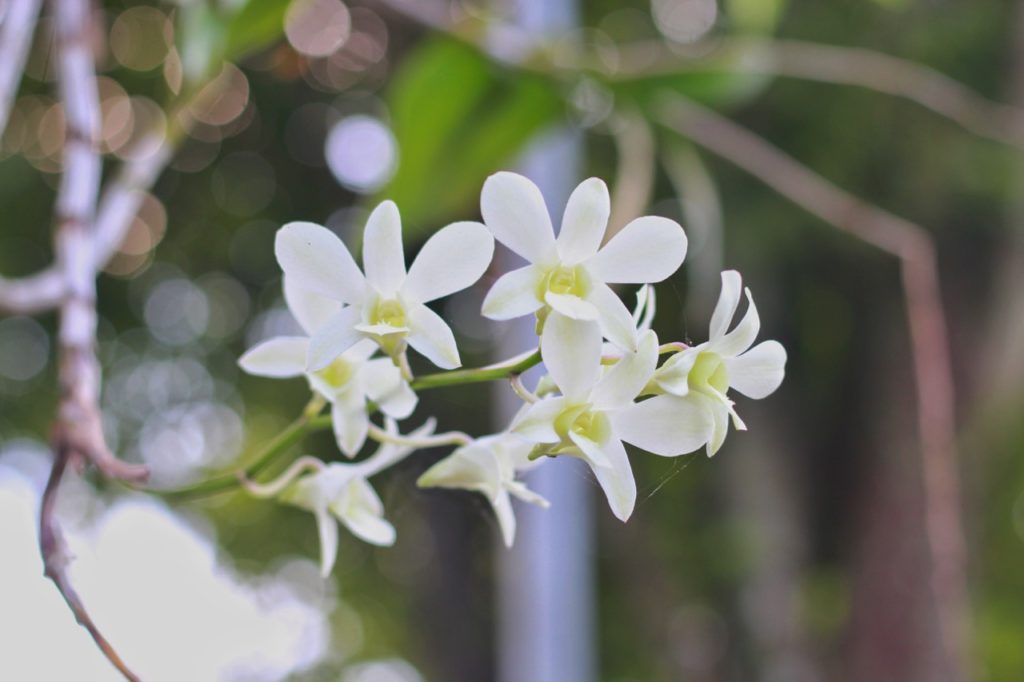
- COMMON NAME(S): pink rock orchid
- HARDINESS RATING: H1B
- FLOWERS: pink, purple and white
- FLOWERING SEASON(S): spring
- SIZE: 0.1-0.5m in height, 0.1-0.5m spread
This orchid is slightly larger than the hybrid listed above.
It is an epiphytic orchid with erect stems and fragrant flowers in purple, pink or white, with a veined or blotched lip that features hints of red or purple.
These flowers are borne in racemes up to 15cm long in the early spring.
8) D. nobile
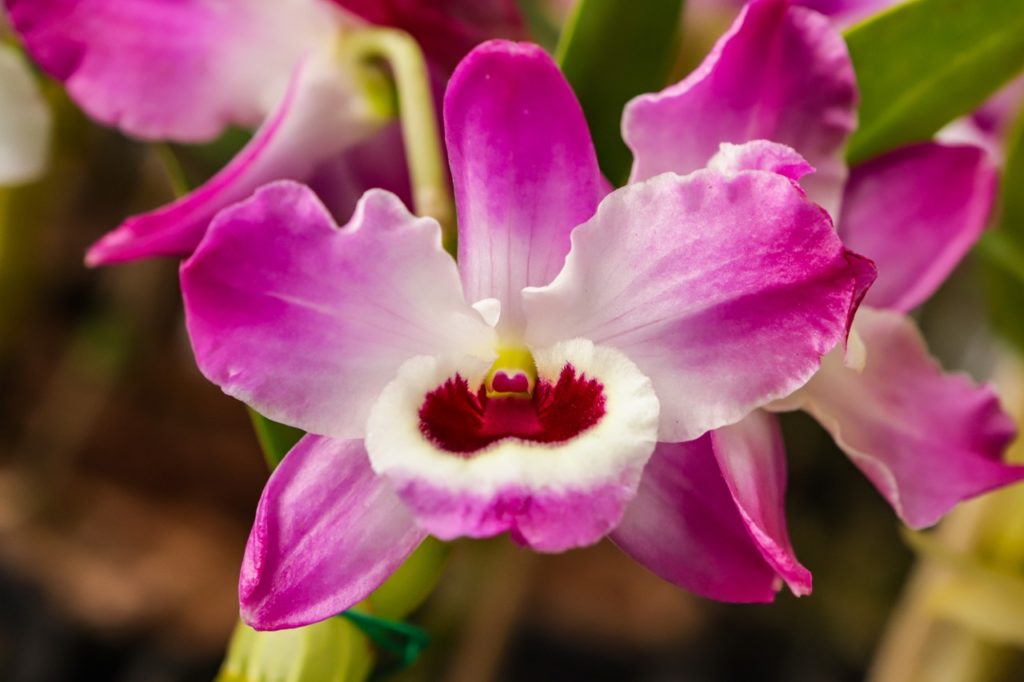
- COMMON NAME(S): noble dendrobium
- HARDINESS RATING: H1C
- FLOWERS: pink
- FLOWERING SEASON(S): winter / spring
- SIZE: 0.1-0.5m in height, 0.1-0.5m spread
Another epiphyte, this orchid is often evergreen in cultivation.
It grows 30cm in height, with ovoid leaves around 5-8cm long.
From winter into spring, these orchids bear trusses of fragrant flowers with a rose pink hue and a deep maroon lip.
Grow in well-drained acidic or neutral soil in a suitable orchid compost, with temperatures between 18-25°C by day and a minimum of 10°C at night.
9) Miltonia ssp.
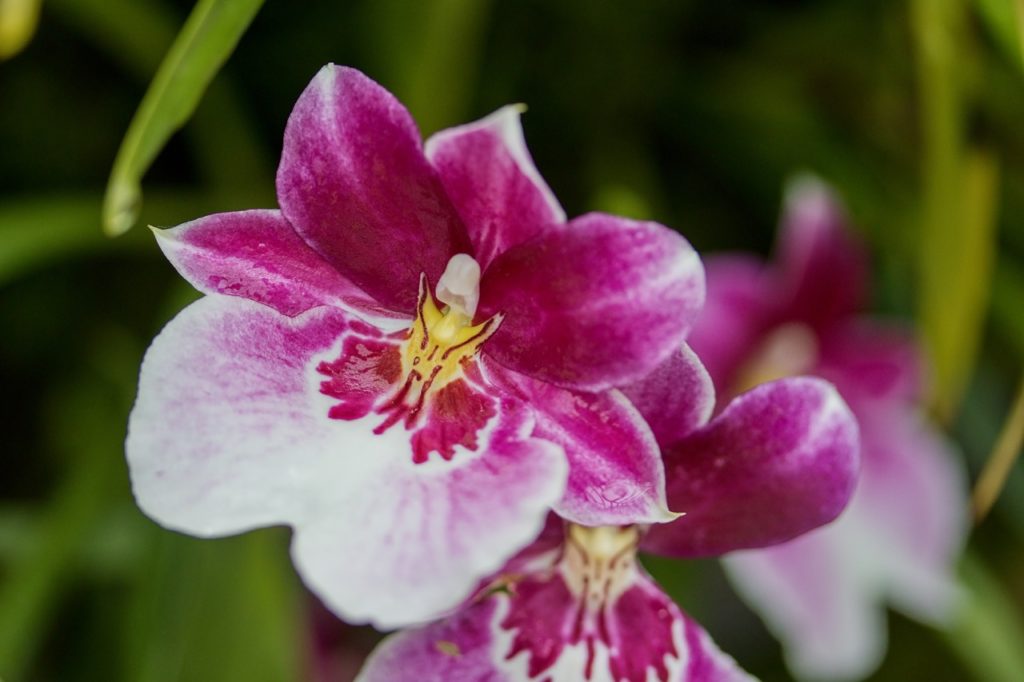
- COMMON NAME(S): pansy orchid
- HARDINESS RATING: H1B
- FLOWERS: varies
- FLOWERING SEASON(S): spring
- SIZE: 0.1-0.5m in height, 0.1-0.5m spread
If you are looking for something different to try, one of the pansy orchids within the Miltonia genus might be an option to consider.
These have large, open blooms in a range of different shades from white through yellow and pink.
Often, they are marked attractively in contrasting colours.
They can be grown in cool to intermediate temperatures and should be kept in bright but indirect light indoors.
10) Oncidium naevium
- COMMON NAME(S): spotted oncidium
- HARDINESS RATING: H1B
- FLOWERS: white and red
- FLOWERING SEASON(S): spring / summer
- SIZE: 0.1-0.5m in height, 0.1-0.5m spread
This is another orchid that might be grown inside the home in a bright conservatory greenhouse.
It is an epiphytic orchid that has a pseudobulb from which new growth emerges.
The leaves that come from the pseudobulb are around 20-30cm long and the flowers, borne on longer, arching stems in winter and spring, are sweetly scented.
These blooms are white and star-shaped, with little red spots and a yellow spot at the centre.
Six or more blooms may develop on mature plants.
The maximum daytime temperature is 25°C and 8°C is the minimum at night.
11) Paphiopedilum ‘Clair de Lune’
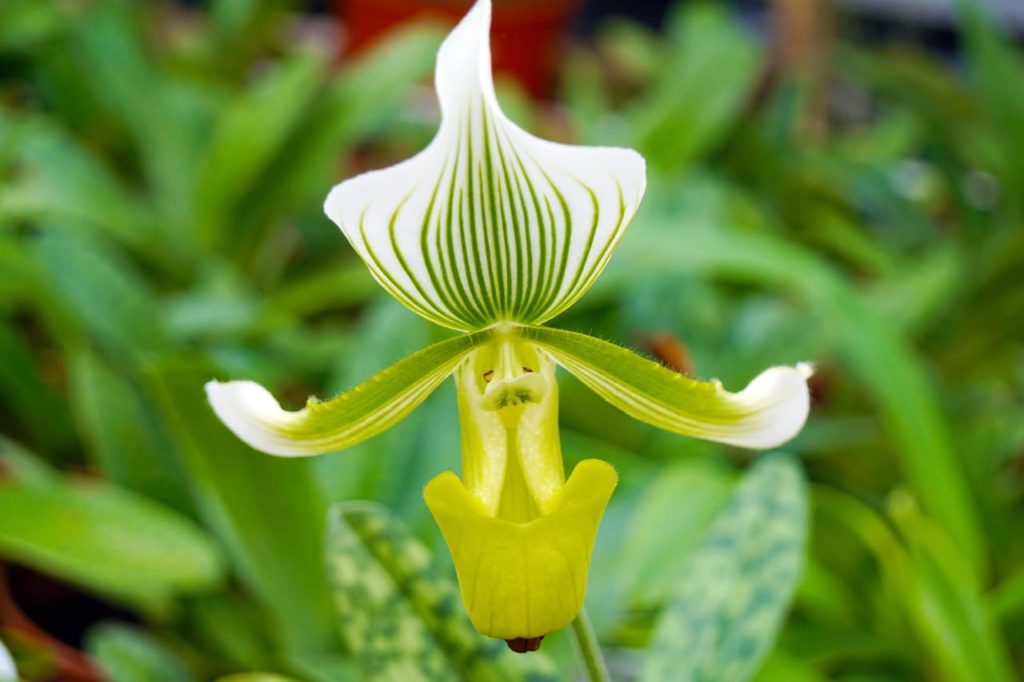
- COMMON NAME(S): slipper orchid ‘Clair de Lune’
- HARDINESS RATING: H1A
- FLOWERS: green and white
- FLOWERING SEASON(S): spring / summer / autumn / winter
- SIZE: 0.1-0.5m in height, 0.1-0.5m spread
Slipper orchids are another type to consider if you want to grow orchids at home.
“I have a mixed collection of a number of genera but specialise in Paphiopedilum,” shares Ken Griffiths, the Chairman of the Bournemouth Orchid Society UK.
“I particularly like them for their form, variety of colour and, in some, the beauty of the leaves.
“There is a very active specialised Paphiopedilum Society in [the] UK, which is the only one of its kind devoted to a particular genus.”
This slipper orchid has leaves that are mottled and dark green, and single flowers up to 10cm across, which are carried on upright stems that are between 15-20cm tall.
The apple green ‘slipper’ largely hides from sight in the green and white fused sepals.
The petals are also green and white, while the upper sepal is white with dark green striping.
12) P. insigne
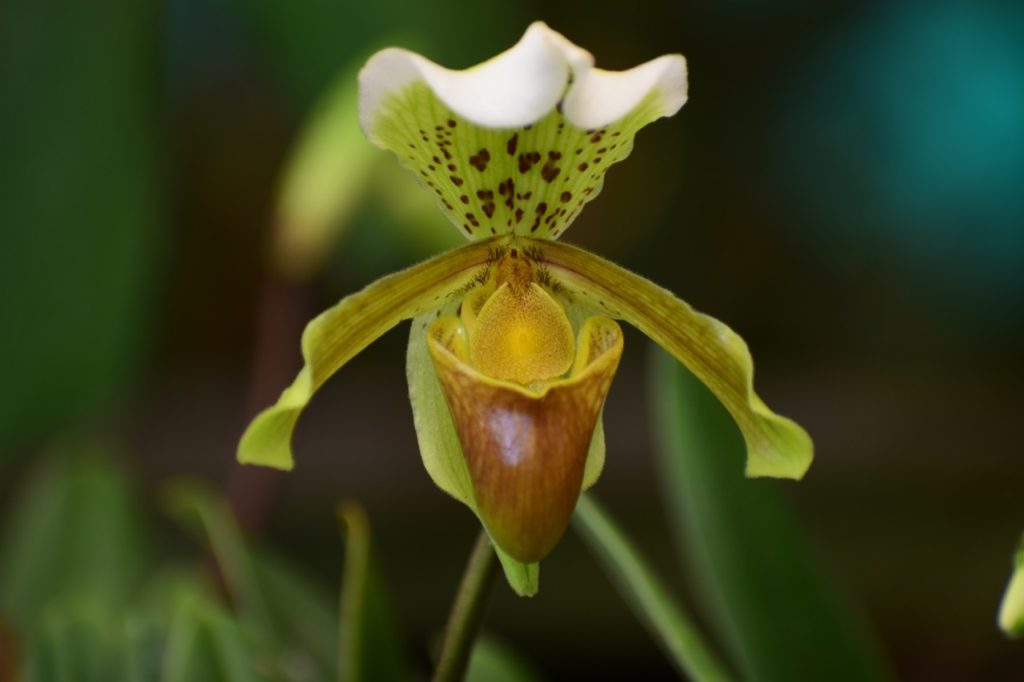
- COMMON NAME(S): splendid paphiopedilum
- HARDINESS RATING: H1A
- FLOWERS: gold and yellow
- FLOWERING SEASON(S): autumn / winter / spring
- SIZE: 0.1-0.5m in height, 0.1-0.5m spread
“Paphiopedilum orchids are a little tricky to grow but come in a wonderful array of colours, look extremely exotic and are one of only a few orchid types that cannot be mass-produced,” says Malcolm Moodie from the Solihull & District Orchid Society.
The splendid paphiopedilum is an evergreen semi-terrestrial orchid.
It has long, narrow, pale green leaves in a rosette form that are around 20-30 cm in length and solo flowers appear from the centre of the rosette.
These flowers are on upright stems that are 15-30cm long and, like other slipper orchids, they have flowers with a pouch that traps insects and allows for pollination.
The petals are yellowy-bronze and the upper sepal is yellow with red spots with a white upper margin.
13) P. ‘Leeanum’

- COMMON NAME(S): slipper orchid ‘leeanum’
- HARDINESS RATING: H1B
- FLOWERS: green, white and red
- FLOWERING SEASON(S): winter / spring
- SIZE: 0.1-0.5m in height, 0.1-0.5m spread
Another slipper orchid to consider, this option grows around 30cm tall.
It has single flowers borne on long stems in winter and early spring that can sometimes appear during other seasons when grown indoors or in a greenhouse.
The flowers are 10cm wide, with a dark reddish-brown pouch, pale green-yellow petals with burgundy markings and an upper sepal that is pale green with burgundy speckles, fading into white at the top.
14) P. ‘Pinocchio’
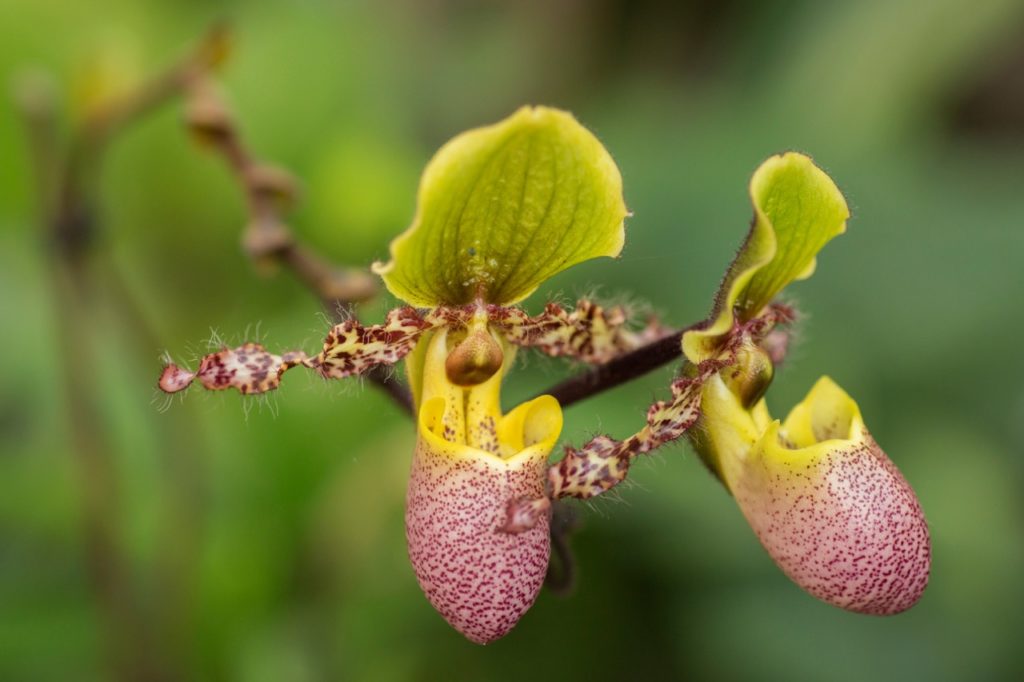
- COMMON NAME(S): venus slipper orchid ‘Pinocchio’
- HARDINESS RATING: H1A
- FLOWERS: green, pink and yellow
- FLOWERING SEASON(S): spring / summer / autumn
- SIZE: 0.1-0.5m in height, 0.1-0.5m spread
The Venus slipper orchid is a hybrid made by crossing P. glaucophyllum and P. primulinum.
The flowers, borne successionally, can appear on the plants and remain in bloom over several months.
They are borne on single spikes and have pink pouches, whitish green side petals with burgundy markings and a lime green sepal up top.
15) Phalaenopsis amabilis
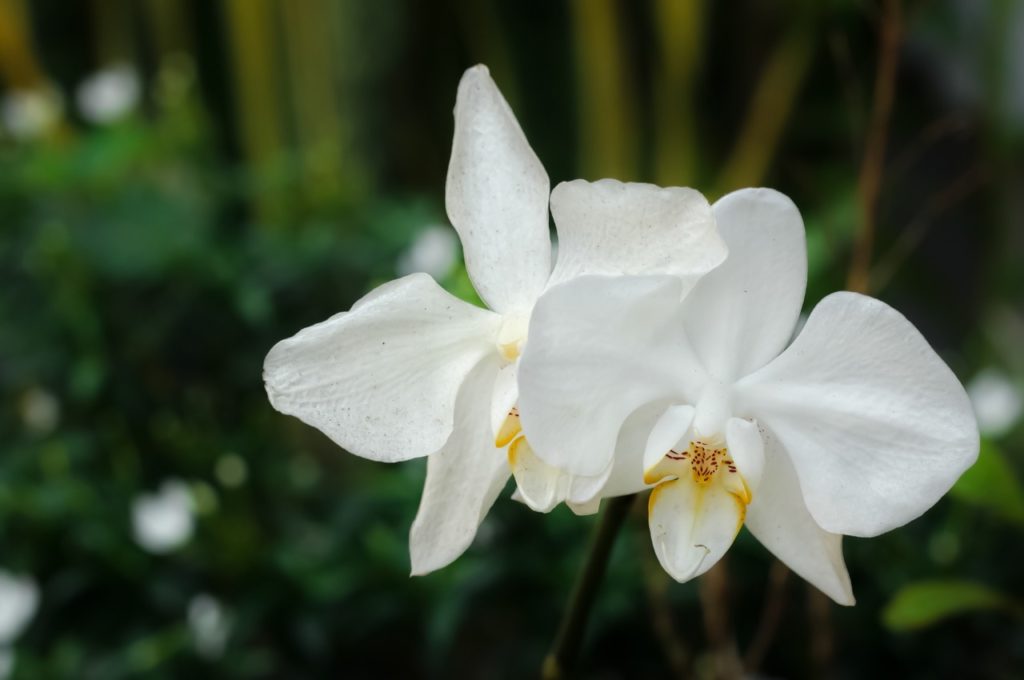
- COMMON NAME(S): moth orchid / East Indian butterfly plant
- HARDINESS RATING: H1A
- FLOWERS: white
- FLOWERING SEASON(S):
- SIZE: 0.5-1m in height, 0.1-0.5m spread
Now we turn our attention to the popular moth orchids that you might grow.
Sometimes referred to as the East Indian butterfly plant, Phalaenopsis amabilis has fleshy, ovoid leaves up to around 50cm long and, from autumn to early spring, bears long-lasting and nicely scented white blooms up to 10cm across on stems that can be up to 1m tall.
Grow indoors in a bright location out of direct sunlight in a spot that receives consistently warm and even temperatures.
16) P. ‘Dover’
- COMMON NAME(S): moth orchid ‘dover’
- HARDINESS RATING: H1A
- FLOWERS: white
- FLOWERING SEASON(S): spring / summer / autumn / winter
- SIZE: 0.1-0.5m in height, 0.1-0.5m spread
This upright, epiphytic moth orchid is an abundantly flowering hybrid option, often producing three flowering stems, around 30cm tall, at the same time.
The flowers are large and white, with mauve colouration at the throat and a yellow lip.
Grow in well-drained neutral soil, ideally with temperatures of around 17°C at night and 20-25°C during the day.
17) P. ‘Picasso’
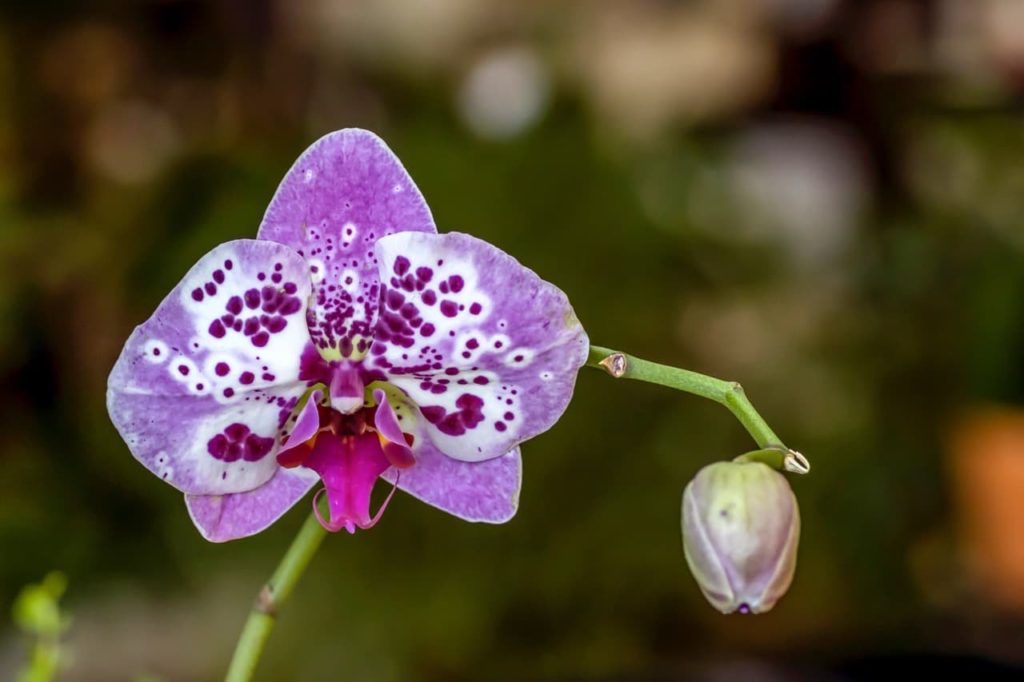
- COMMON NAME(S): moth orchid ‘Picasso’
- HARDINESS RATING: H1A
- FLOWERS: pink and white
- FLOWERING SEASON(S): spring / summer / autumn / winter
- SIZE: 0.1-1m in height, 0.1-0.5m spread
Another upright-growing epiphytic orchid, this option often also bears a couple of flowers at the same time, each flowering stem growing around 60cm in height.
The flowers are interesting, being of a harlequin type, and no two flowers are exactly identical.
However, they are broadly white with a dark burgundy heart and scattered burgundy spotting, a burgundy-orange lip and a whitish-yellow edge on the side lobes.
18) P. ‘Sunshine’
- COMMON NAME(S): moth orchid ‘sunshine’
- HARDINESS RATING: H1A
- FLOWERS: yellow and orange
- FLOWERING SEASON(S): spring / summer / autumn / winter
- SIZE: 0.1-0.5m in height, 0.1-0.5m spread
This is an upright and relatively compact orchid that grows around 30cm tall.
It has long-lasting blooms which are mostly yellow in hue, with maroon freckles scattered across them and an orange lip.
These orchids can also thrive in warm, even temperatures in bright but indirect light.
19) P. ‘White Apple’
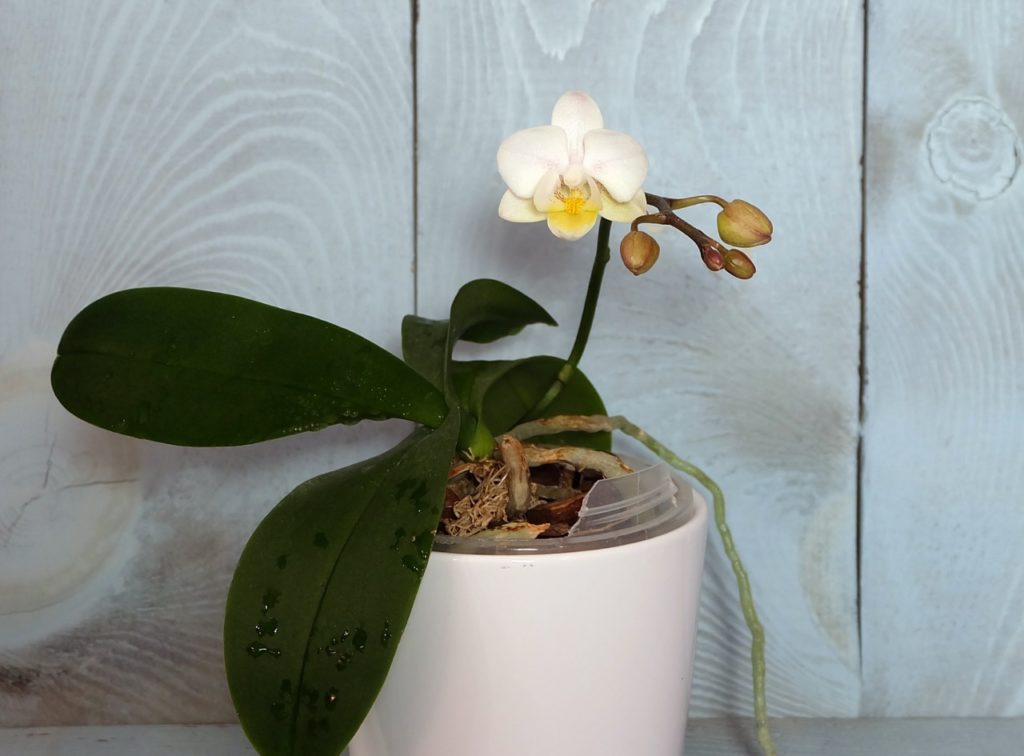
- COMMON NAME(S): moth orchid ‘white apple’
- HARDINESS RATING: H1A
- FLOWERS: white
- FLOWERING SEASON(S): spring / summer / autumn / winter
- SIZE: 0.1-0.5m in height, 0.1-0.5m spread
Another upright, epiphytic orchid, this one has ovoid, dark green leaves that are 15cm long and numerous long-lasting flowers on semi-pendulous branched racemes around 30cm in length.
Each flowering stem carries around 15 flowers which open in succession.
These blooms are white with a blush of pink and some mauve on the reverse side.
The lip is yellowish and spotted in the centre.
20) P. ‘Yellow Lightning’
- COMMON NAME(S): moth orchid ‘yellow lightning’
- HARDINESS RATING: H1A
- FLOWERS: yellow and red
- FLOWERING SEASON(S): spring / summer / autumn / winter
- SIZE: 0.1-0.5m in height, 0.1-0.5m spread
This moth orchid has broadly oval leaves and arching stems which boast a series of yellow flowers that have reddish tips towards the edges and purple at their centres.
These flowers bloom over a long period and can appear at any time of the year.
